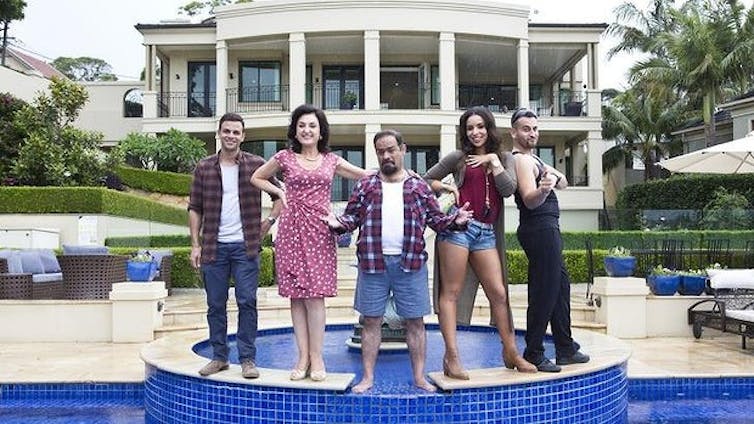From 'Leb bread' to 'Leb Kelly', finally we're seeing more Middle Eastern faces on TV
- Written by Cherine Fahd, Senior Lecturer Photography, School of Design, University of Technology Sydney
I have recently started watching Gogglebox, an immensely humorous reality television show on Channel 10 (and Fox’s LifeStyle Channel), where you watch families watch television.
I must admit my initial interest in the show, already in its sixth season, was motivated by self-interest. My youngest brother Matthew (AKA Matty) along with my soon-to-be sister-in-law Sarah Marie and their best friend Jad, are the new “family”. The trio of Lebanese heritage were chosen to “increase the show’s diversity” by “adding a Middle-East flavour” to the Logie award-winning series.
Watching TV in the 1970s, ‘80s and '90s highlighted what I already understood from the school playground: “Lebs”, or “wogs” more generally, were too different and too dark in appearance to be “real” Australians.
Appearance was not the only factor. Our “foreign” food and cultural rituals were made stranger by their invisibility outside of our domestic sphere. We certainly did not encounter non-Anglo actors eating humus in soapies such as Neighbours and Home Away (we still don’t). To make matters worse, when we were visible it was in negative news stories portraying the Lebanese civil war (1975-1990), or local crime stories on gang rape, drive-by shootings or drug syndicates.
While these negative portrayals persist in the name of national security and the “war on terror”, Australian commercial television appears to be more willing of late to present a balanced and more diverse portrayal of its citizens.
Channel 9 seems to have adopted a similar “diversity” strategy to Channel 10 (both networks have signed up to the Screen Diversity and Inclusion Network Charter), launching the second season of Here Come the Habibs!, a sitcom about a Lebanese family who win the lottery and move from the “'burbs into Australia’s richest suburb”.
 The cast of Here Come The Habibs!
Channel 9
The cast of Here Come The Habibs!
Channel 9
This embracing of diversity is even more apparent in Nine’s new cooking series, Family Food Fight. According to the show’s official website, the cooking series presents “diverse and multi-generational Australian families” in competition for the title of “Australia’s Greatest Food Family”.
One family, the “Shahrouk Sisters”, wearing their signature coloured headscarves, presents a welcome alternative to the usual menacing representation of Lebanese women from Islamic faith. The sisters cook abundant Lebanese style banquets while chatting (shouting) in a competitive and humorous manner with each other. They, like the other contestants, represent “ordinary” Australians.
This change is possibly in part thanks to Waleed Aly’s 2016 Gold Logie win: a rare occasion to witness a good news story about an Australian with Middle-Eastern heritage (and appearance). The win created a mood of hopefulness which may encourage future talent from non-Anglo backgrounds to try their luck in the Australian entertainment industry.
Still, while it may have taken Australian television networks 60 years to represent its citizens in diverse forms, there remain interesting questions about this depiction in terms of racial and cultural stereotypes.
When watching Gogglebox I am acutely aware of my tendency to label the families according to a “type” – the gay boys, the Greek girls, the art collectors, the blonde family, the Sri Lankan’s and now the Lebs.
It is also fascinating to consider how the participants may consciously or unconsciously perform themselves; a performance transcribed by often the humorous and accessible stereotypes seen in pop culture.
For example, in Here Come the Habibs! the boys love doing burn outs in hotted up cars, the women are heavily made up with big hair, and the whole family wear “bling”. Not to mention wearing satin tracksuits while using Lebanese-English to speak to each other via a lot of yelling.
But this is not a criticism. In fact, performing these stereotypes may offer an alternative to the pressure different groups face to completely assimilate into the dominant (Western culture).
I would never have imagined as a child disclosing my “Lebanese-ness” publicly. In the '80s I would not have taken “Leb bread” to school, it was certainly a no-no to speak Lebanese in public, or make any reference to our cultural rituals.
Clearly this has changed. Back on Gogglebox, Anastasia speaks to Faye in both English and Greek (“language switching”) and Matty declares himself “Leb Kelly” when coming face-to-face with a portrait of Ned Kelly, sporting a resemblance to his very own “hipster” beard.
Australians from culturally diverse backgrounds seem to have stopped hiding, and are resisting assimilation to present a more authentic and diverse portrayal of the nation.
Authors: Cherine Fahd, Senior Lecturer Photography, School of Design, University of Technology Sydney





